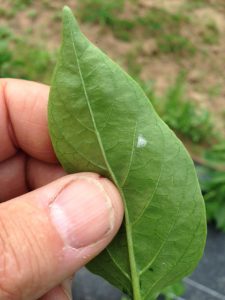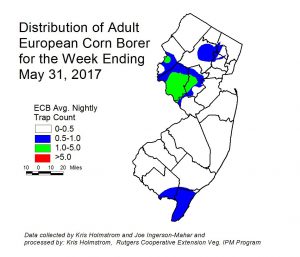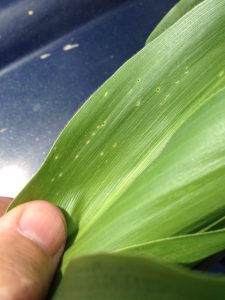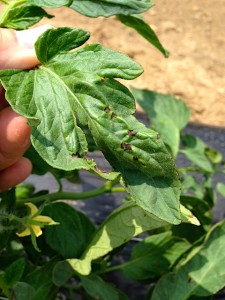There has been little change in European corn borer (ECB) catches over the past week. We would have expected some increase throughout the state, but prolonged wet weather has likely slowed their activity. The highest catches remain in southern Hunterdon County (see map at left), although there have been low, but steady catches elsewhere, including northern Cumberland and central Morris counties. Feeding continues to be very limited, but should increase with drier conditions later this week. Check 5 plants each in 10 random locations for a 50 plant sample. Look for “shot-hole” injury (see photo at right), and consider treating when the number of infested plants in a 50 plant sample exceeds 12%.
The highest nightly ECB catches for the previous week are as follows:
| Sergeantsville 4 | Georgetown 1 |
| South Branch 3 | Matawan 1 |
| Centerton 1 | New Egypt 1 |
| Downer 1 | Old Bridge 1 |
| East Vineland 1 | Tabernacle 1 |
| Elm 1 | Woodstown 1 |
Very few corn earworm (CEW) moths were captured in blacklights over the past week. These individuals indicate that there was limited overwintering of this pest in NJ, but are of little concern in the absence of silking sweet corn. As numbers increase, CEW maps will appear in this publication.
With cool wet weather, garden slugs can become a problem in seedling stage sweet corn. These mollusks feed on the small plants, leaving large holes. Repeated feeding can kill seedlings. Slugs will hide under soil clods or crop debris during the day. If injury has occurred, dried slime trails on the plants will be evidence that slugs were responsible. Extreme feeding and a forecast of cool wet weather may be reason enough to broadcast slug bait on affected areas.
Cole Crops
Imported cabbageworm butterflies (ICW) are active when weather permits, but infestations remain fairly low for this time of year. Egg laying is ongoing, and infestations of this pest should increase quickly with better weather. Scout plantings weekly. Check 5 consecutive plants each in 10 random locations throughout the planting, paying particular attention to the innermost leaves where ICW often feed. Consider treating if caterpillars are found on 10% or more plants that are in the 0-9 true leaf stage. From 9-leaf to the early head stage (in broccoli, cauliflower and cabbage) infestations up to 20% may be tolerated. Once heads begin to form, a 5% threshold should be observed to protect the marketable portion of the plant. For leafy greens such as collards and kale, 10% plants infested is the threshold throughout.
Tomatoes
Avoid working in wet tomato fields if at all possible. If bacterial infections are present in this crop, the pathogen may be spread by contact. Bacterial lesions are frequently black in color (see photo at left), and are often present on the newest foliage, whereas early blight lesions and many symptoms of stress related nutritional deficiencies are often found on the older leaves. All tomato plantings should get the full anti-bacterial program found in the recommendations guide. This includes weekly fixed copper sprays (organic and non-organic systems) as well as the use of the immune response activator Actigard, and Quintec, a fungicide with some activity against bacterial pathogens.
Peppers
 New pepper plantings are now threatened by the ECB, as moths lay eggs on the underside of pepper leaves (see photo at left). Larvae will hatch and bore into central stems of these small plants, causing the tops of the plants to die. While this is not terminal, it will prevent the production of crown fruit on affected plants. Scout 5 plants each in ten random locations. Check the underside of 2 leaves per plant. If 2 or more ECB eggmasses are found in this sample consider treating with a foliar insecticide or a soil applied insecticide such as Coragen. There are several options listed in the 2016-17 Commercial Vegetable Production Recommendations, including the OMRI approved spinosyn material, Entrust.
New pepper plantings are now threatened by the ECB, as moths lay eggs on the underside of pepper leaves (see photo at left). Larvae will hatch and bore into central stems of these small plants, causing the tops of the plants to die. While this is not terminal, it will prevent the production of crown fruit on affected plants. Scout 5 plants each in ten random locations. Check the underside of 2 leaves per plant. If 2 or more ECB eggmasses are found in this sample consider treating with a foliar insecticide or a soil applied insecticide such as Coragen. There are several options listed in the 2016-17 Commercial Vegetable Production Recommendations, including the OMRI approved spinosyn material, Entrust.
Pepper Weevil Update
Two more weevils were trapped this week in the Hammonton area. So far as is known, there are no infested fields in the region.




